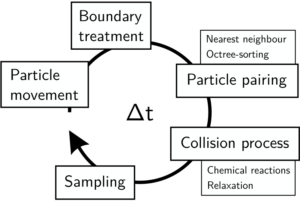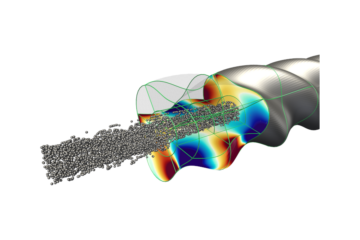Understanding the behavior of rarefied gas flows has long been a challenging task, however, using the Direct Simulation Monte Carlo (DSMC) method, this can be achieved for a wide variety of simulation applications.
Introduced by Graeme A. Bird, DSMC is a computational particle method for simulating the behavior of rarefied gas flows. Unlike continuum-based methods, which assume that the gas behaves as a continuous medium, DSMC takes into account the molecular nature of gases and approximates the interactions between individual particles. It works by simulating the movement of a large number of representative gas molecules through a computational domain, where each simulation particle represents a certain number of real atoms or molecules. The simulation proceeds in discrete time steps, with particles moving freely between collisions and interacting with each other and with surfaces.

The key steps of a typical time step involved in a DSMC simulation include the following points, which are repeated until the desired simulation time is reached:
- Particle Movement: Moving the individual particles through the computational domain based on their velocities and the time step size.
- Boundary Interactions: Handling of interactions between particles and boundaries. For solid boundaries, reflections, energy accommodation, and adsorption are considered, and energy values at the surface can be evaluated.
- Particle Pairing: Particle pairs are selected for a potential collision, either randomly or through a nearest neighbor search.
- Collision Process: The collision process between the selected particle pairs can lead to relaxation of inner degrees of freedom as well as to chemical reactions. In addition, the velocities of the particles are updated.
- Statistical Sampling: Sampling of macroscopic flow properties, such as velocity, number density and temperature by evaluating the moments of the particle distribution functions.
By statistically modeling particle collisions, DSMC can accurately capture non-equilibrium effects that are often present in rarefied flows. It is also capable of simulating high gradients even in near-continuum regimes, making it suitable for simulating various applications such as space applications (atmospheric entry and space propulsion), vacuum technology (molecular drag pumps, vacuum chambers, gas distribution in coating chambers, PVD coating processes), and microelectromechanical systems (MEMS). It is inherently parallelizable, allowing simulations to be run efficiently on high-performance computing clusters.
While DSMC is a powerful tool, it also has some drawbacks: Simulating dense flows and large numbers of individual particles becomes computationally expensive, especially for complex, three-dimensional geometries and low Knudsen numbers. The accuracy of the simulation often requires careful tuning of simulation parameters such as particle number, grid resolution and time step size. Our open-source simulation code PICLas addresses and minimizes these drawbacks by coupling DSMC with other particle methods that are faster for near-continuum flows (Bhatnager-Gross-Krook and Fokker-Planck) and routines that are independent of grid resolution (such as an automatic octree cell refinement scheme), while still paying attention to the physical correctness of the results. For an overview over the available particle methods and the features of our DSMC solver please refer to the dedicated Particle Methods section.
Frequently Asked Questions
How does the accuracy of DSMC simulations compare with experimental data in real-world applications?
The accuracy of DSMC when compared with experimental data generally shows good agreement, especially in scenarios where the molecular nature of gas flows is significant, such as in atmospheric re-entry or in vacuum systems. However, the level of agreement can vary depending on the complexity of the flow, the certainty regarding the boundary conditions, the accuracy of the molecular interaction models used, and the simulation parameters. The DSMC method in PICLas has been extensively validated as shown in the application case studies.
What are the specific challenges in simulating chemical reactions within rarefied gas flows using the DSMC method?
Simulating chemical reactions within rarefied gas flows using DSMC presents specific challenges, including accurately modeling the reaction kinetics and energy exchange processes at a molecular level. Addressing these challenges requires detailed chemical reaction models and precise algorithms for calculating reaction probabilities. Most DSMC codes incorporate the Total Collision Energy (TCE) and/or the Quantum-Kinetic (QK) model. While the first relies on Arrhenius-type reaction rates, the QK model treats reactions on a microscopic level. Additionally, a cross-section based chemistry model is implemented in PICLas, allowing the use of tabulated energy-dependent cross-section data.
Can DSMC simulations be coupled with computational fluid dynamics (CFD) methods to simulate the transition between rarefied and continuum flows?
While DSMC can be coupled with conventional CFD methods, this integration remains an active area of research. A significant challenge arises at the interface between a statistical, particle-based method and an equation-based method. In PICLas, the decision was made to utilize continuum-based particle methods to allow for a straight-forward, bidirectional coupling without the need of a complex buffer region. At the same time, these methods enable an efficient and physically correct simulation in the transition region between continuum and rarefied gas flow. An example of a coupled ESBGK-DSMC simulation is shown by means of a nozzle expansion of a cold-gas thruster.
If you are interested in the DSMC method and how PICLas can be used for your specific application, please contact us!


